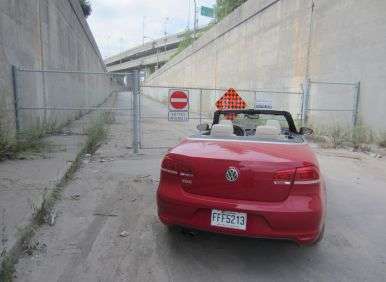Recent Articles
Popular Makes
Body Types
2012 Volkswagen Eos Road Test and Review
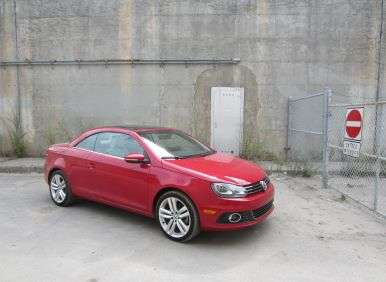
When Volkswagen set about replacing the Golf Cabriolet in the mid-2000's, the company elected to break with tradition and offer a unique model based on a somewhat larger, and more comfortable platform. The Volkswagen Eos took VW's affordable convertible concept up-market, introducing a retractable steel roof and improving interior room to give it true four-passenger capability. It also became something of a novelty on the market thanks to its premium positioning and affordable pricing.
The 2012 Volkswagen Eos represents the first refresh of the drop-top since it was first introduced in 2006, and while the changes have been largely cosmetic, they are a welcome update to the compact car.
2012 Volkswagen Eos: Competition
The 2012 Volkswagen Eos straddles an interesting line between the world of premium convertibles like the much more expensive Infiniti G37, Lexis IS, and Audi S5, and attainable models like the Chrysler 200. Essentially, the Eos can be thought of as a 'tweener,' a vehicle that is chosen by buyers who want to drive something a little more upscale than a Chrysler but who aren't willing to drop major coin on a traditional entry-level luxury car. In this sense, its closest competitor would be the Volvo C70, another European hardtop convertible that attempts to bridge the gap between these two segments - albeit with a price tag that starts roughly $5,000 higher.
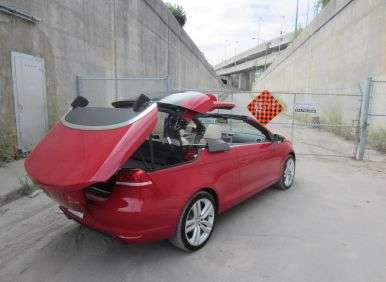
2012 Volkswagen Eos: Pricing and Trim Levels
The 2012 Volkswagen Eos is available in four different trim levels, starting out with the Komfort (MSRP $34,350) and ranging all the way up to the Executive (MSRP $40,945). It is interesting to note that the price spread between the penultimate Lux trim and the Executive model is only $1,745, which essentially pays for the premium sound and navigation system found in the latter.
Our test car was a Canadian-market Eos ordered in a model that fit just below the American Executive trim. The vehicle was also loaded up with a significant number of options - so many that it pushed into Executive territory, and gave it a price tag of roughly $39,000.
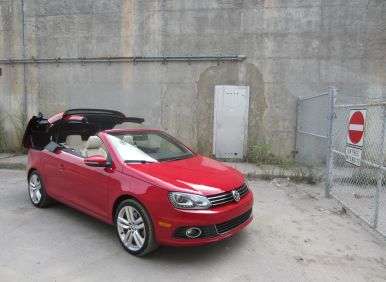
2012 Volkswagen Eos: Exterior
The 2012 Volkswagen Eos has two very distinct visual personalities. The first, and most obvious, is its carefree look when the vehicle's top is stowed. The Eos appears longer and somewhat wider than the Golf Cabriolet it replaced so many years ago - which makes sense, given that it is based on a more generously-proportioned platform - but it doesn't seem to stretch out quite as far as a BMW 3 Series or Audi S5 convertible, allowing it to preserve its compact identity. From some angles, however, the stubby front and seemingly flared back ends can appear awkward. This is a car that is best viewed from a three-quarter angle, rather than being gazed at from the side.
With the top up, the Volkswagen Eos' short rear deck becomes even more pronounced. This is not necessarily a bad thing, but it enhances the severity of the C-pillar's angle and gives the hardtop somewhat of a 'bubble' feel. The roof's integrated glass sunroof - yes, a convertible with a sunroof - works well with the blacked-out rear roof panel to create a two-tone look that perfectly offset the bright red paint on our test car. 18-inch rims also added a degree of heft to the Eos' appearance.
2012's makeover brought a number of tweaks to the convertible's exterior styling, including a new grille that matches the face of the VW brand across the lineup, LED running lights, LED tail lights, and a few aerodynamic additions that provide a sportier, sleeker look for the Eos. That being said, the VW remains an 'unusual' vehicle - you either get it, or you don't, from a stylistic standpoint, and while most of us at Autobytel were enamored of its simple and clearly-stated lines, we encountered a number of pedestrians and passengers who clearly weren't as intrigued by the Eos' design.
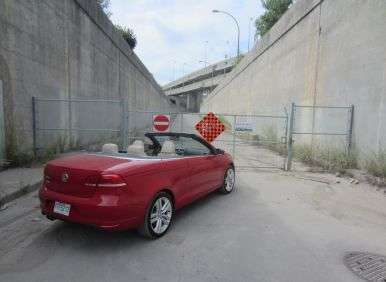
2012 Volkswagen Eos: Interior
The 2012 Volkswagen Eos passenger compartment is perhaps its greatest tool for convincing would-be buyers that they are indeed looking at a near-luxury car. Volkswagen has done an excellent job of making sure that each surface that might be touched is soft, every control stalk or switch that could be interacted with feels solid, and that all buttons respond with the correct amount of resistance when pressed. The dash layout is straightforward, with small round gauges nested within the tachometer and speedometer directly in front of the driver, and the vehicle's navigation and entertainment system LCD screen centered at the top of the vehicle's stack, where it is surrounded by an attractive silver metallic frame.
The trim in the VW Eos is mostly composed of straight lines or gently-curving descending motifs, and the pale cream color of the seats and paneling in the vehicle we drove over the course of the past week was complimented by the black dashboard and top sills. The Eos' heated leather seats were quite comfortable for those riding up front, and while the rear buckets provide additional accommodations for two more passengers they had better not be to many years past their teens due to its smaller confines. The Eos also came with a wind deflector the could be deployed from the top of the windshield in order to reduce buffeting for backseat riders, but as we didn't subject anyone to the perils of rear seat, top-down driving we can't vouch for its effectiveness.
In addition to sporting an interior that is easy on the eyes, a welcome degree of attention has been paid to the way in which the driver interacts with the vehicle's various systems. The VW convertible's steering wheel features dual control pads - identical in design - for interacting with the stereo system and the driver information screen located at the center of the gauge cluster. The arrows on these pads are delightfully simple to use, providing clear feedback when pressed correctly and offering a logical way of navigating through various menus and options choices. Ford's MyFord Touch system could learn a lot from the way VW has implemented its steering wheel controls. We also were able to easily interact with the touchscreen when we needed to input an address into the navigation system, or change satellite radio presets. Amusingly, the Eos allows for the display of four distinct compasses showing the car's current heading at any given time - two on the touchscreen, and two on the driver's information screen - just in case one, two, or three indications of magnetic north aren't enough.
Despite our overall happiness with the Volkswagen's ergonomics, we do have a few complaints about the driver / vehicle interface found in the VW Eos. In Montreal, we often have to change fleet vehicle display systems from French to English immediately after picking them up, and the Eos - like a few other models out there - requires this to be done not just on the touchscreen interface, but also on the driver's information screen in order to have all systems speaking the same language. This splitting of systems setup features is also repeated when attempting to link a phone via Bluetooth. The touchscreen offers a limited set of phone options, but no linking feature - that has to be done via the driver's screen using the steering wheel controls. Once it's connected, the voice command system works quite well, but there's no need to disperse phone settings across two different interfaces.
There were also times when it took the vehicle's LCD screen at least a minute to boot-up, which meant no stereo or navigation access during that period. This is an unusual state of affairs in a world where even inexpensive automobiles feature lightning-fast system load times.
We would be remiss in our discussion of the Volkswagen Eos interior if we didn’t mention the functionality of the vehicle's retractable hardtop. Raising and lowering the top occurs relatively quickly - and semi-spectacularly - with the push or pull of a silver handle mounted just below the (extremely tiny) center console. Volkswagen has also seen fit to provide a single button for raising and lowering all four windows, should one want to cruise in B-pillarless nostalgia.
The sunroof integrated into the hardtop is a fun feature, but ultimately more of a gimmick. After all, if it's that nice out, wouldn't you just put the top all the way down? We also noticed that while the vehicle was relatively quiet inside with the roof raised, even on the highway, cowl shake was still noticeable whether the top was up or down. Unlike other premium hardtop convertibles, you can't operate the roof while crawling forward in traffic, as the vehicle has to be completely immobile for the mechanism to function. Volkswagen does provide additional peace of mind, however, by making use of its sonic parking sensors to automatically check and see whether there is enough room to open the trunk lid without hitting an obstacle, before activating the roof.
A final word on the roof: with the top down, there is a surprising amount of room in the trunk - enough for more than a few small-to-medium-sized bags. In fact, the amount of cargo space offered by the Eos with the top stowed verges on cavernous when compared against many of its more expensive hardtop convertible rivals.
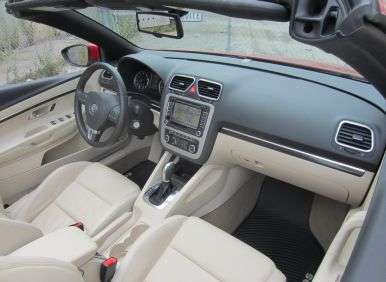
2012 Volkswagen Eos: Powertrain and Fuel Economy
The 2012 Volkswagen Eos features a 2.0-liter, four-cylinder engine that makes use of a turbocharger to produce 200 horsepower and 207 lb-ft of torque. The front-wheel drive Eos is shifted via a six-speed, dual-clutch automated manual transmission (or DSG in Volkswagen parlance), which can be left in automatic mode or run through the gears using steering wheel-mounted paddles. The six-speed manual has been eliminated from the options list for 2012. Fuel mileage for the convertible checks in at 22-mpg in stop and go driving and 30-mpg on the highway, and we were able to match its listed 25-mpg rating for combined driving during our time with the vehicle.
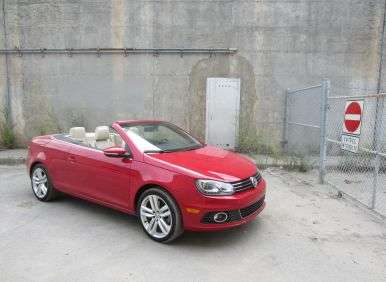
2012 Volkswagen Eos: Driving Impressions
The 2012 Volkswagen Eos is surprisingly nimble for a compact convertible. VW has not marketed the Eos under any sporty pretensions, preferring instead to highlight the calm and comfortable ride offered by the automobile and its overall stylish design, but there's no denying that this is one drop top that is perfectly happy to snake its way along side roads. This isn’t the kind of car you'd want to push throw a cone slalom at an autocross event, but its chassis certainly doesn't give up the ghost at the first sign of a bend in the road, which is an admirable accomplishment for an affordable convertible.
Acceleration is also strong in the Eos, which is another revelation given its relatively portly curb weight (around 3,500 lbs) and its four-cylinder engine. Once again, Volkswagen has worked turbocharged magic, as the 200 horses squeezed out of the 2.0-liter mill that sits underneath the hood of the Eos suffers from no noticeably lag and is able to spin the tires off of the line if desired.
We were especially impressed with the DSG automated manual transmission that comes standard with the Volkswagen Eos. Shifts from one gear to another using the steering wheel paddles were accomplished with exceptional rapidity and smoothness, regardless of whether one was going up or down a cog. When left in either D or S (for Sport), the transmission also handled itself quite well. We were able to detect a bit of hunting when loafing around at cruising speed, or when asking for moderate acceleration off of the line, but neither of these characteristics associated with the DSG gearbox detracted from the overall experience of using it.
As pleased as we were to drive the Eos, top up or down, our time with the vehicle was unfortunately cut short when one morning it simply refused to start. One of our test garages features a steep incline immediately before its door, and the Eos was left parked there for a period of roughly three hours before it was needed again. Upon attempting to start the vehicle, it fired up, stumbled, and then stalled. The engine would turn over, but refused to catch, despite showing a quarter tank of fuel available. Suspecting that the extreme angle of the driveway was to blame - perhaps the fuel tank pickup was sitting above the fuel line - we let it sit for 30 minutes only to try our luck again.
The second time, the tank revised its reading to show it as empty. Puzzled, we trekked over to the local filling station, brought back a gallon of gas, dumped it into the Eos, and had it fire right up. After driving the car to the same gas pump and topping it up, it was revealed that we indeed had a quarter of a tank already in the car, which made us question why the Eos had become such a finicky starter. Many other test vehicles have been parked on that same angled stretch of driveway and never displayed the same behavior, so we sent the convertible back to Volkswagen to see if they could diagnose the issue. At the time of publication, we are still waiting for an answer, and the no-start condition remains an unfortunate blemish on our week with the Eos.
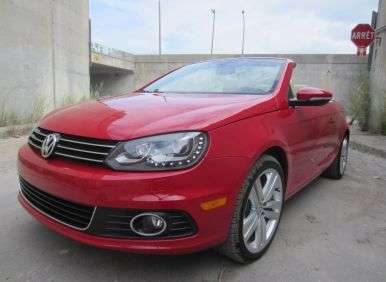
2012 Volkswagen Eos: Safety
The 2012 Volkswagen Eos features a full complement of airbags, including seat-mounted side airbags and dual-stage forward units. Side curtain airbags aren't available with the convertible, but it does come with a rollover protection system that includes pop-up steel beams that extend from behind the rear seat in order to buttress the windshield's ability to support the weight of the car. Electronic stability control and traction control are standard with the Eos, and Volkswagen also includes its "Intelligent Crash Response System," which cuts power to the fuel pump and flashes the hazards after airbag deployment.
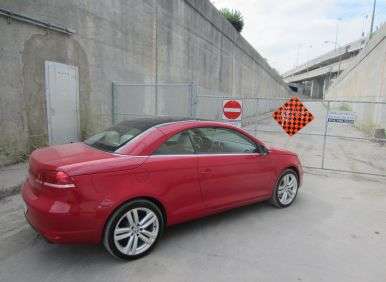
2012 Volkswagen Eos: Final Thoughts
The 2012 Volkswagen Eos stands tall as roomy convertible that doesn't ask buyers to drain their bank accounts in order to enjoy a premium interior and a retractable hardtop that adds four-season practicality to the equation. Excellent power, respectable fuel efficiency, and handling that is a cut above expectations are also included with this particular model.
We enjoyed our time behind the wheel of the Eos, but were left frustrated with its refusal to start and subsequent early removal from our fleet. These kinds of seemingly random quality issues have plagued Volkswagen on and off for the better part of a decade, and they must unfortunately be kept in mind when shopping for an automobile wearing the VW badge.
What We Like About The 2012 Volkswagen Eos
- Appealing styling, inside and out.
- Excellent ergonomics and interface design.
- Comfortable ride, good handling, solid power.
- Attractive pricing compared to rivals.
We Aren't So Hot On:
- Puzzling refusal to start.
- Splitting of language / Bluetooth setup feature across two different interfaces.
- Slow load times for navigation / entertainment system.
